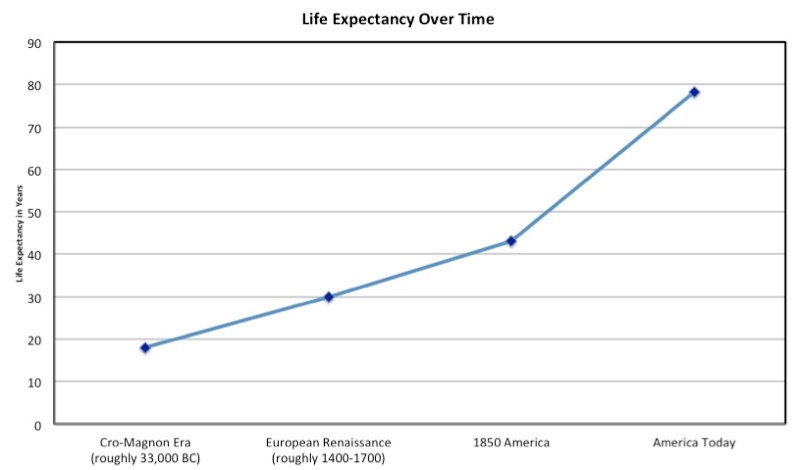
Thanks to Eugene for inviting me to guest blog this week about my new book 100 Plus: How the Coming Age of Longevity Will Change Everything, From Careers and Relationships to Family and Faith.
As you can see from the chart above, humanity has made great progress in extending average human life span, and much of that progress happened in the last century and a half. But that is only the beginning. New technologies will continue the extension at an even faster rate.
In my book, 100 Plus, I make the argument that, because of advances in regenerative medicine and biotechnology, it won’t be long before humans will be able to extend their health spans to over 100 years. Notice that I don’t simply use the term “life span” but instead discuss “heath spans.” That is because health will be extended along with life.
How will this longevity revolution affect society? That is the subject of the rest of the book. I take the position that a health span of 150 years is achievable and base the rest of the social, economic, and cultural analysis on that horizon.
Biology has now become an engineering project. Just as computer programs have 1s and 0s, so too does the human body have a code, made out of the ACTGs of DNA. Now that the human genome has been sequenced, work continues on figuring out how to reverse engineer the human body.
The field of regenerative medicine is incredibly exciting and one of the most promising techniques so far goes by the name of tissue engineering, which offers the ability to build new organs for those that have worn down, like a heart or a lung. Already, scientists have grown and successfully transplanted human organs, such as bladders and windpipes, for patients in need.
Human hearts and lungs have not been completed yet, but promising work in lab animals suggests it will be possible. How long will it be before patients will be going to the hospital for brand new hearts? It’s hard to predict, since science can always run into problems and there will be a number of safety tests. I’m confident it will happen within my lifetime (I’m 39 years old). Once we have a large enough parts list, we will be able to keep humans healthy by replacing parts as they wear down, just like we do with vintage cars that are in tip top shape.
Another important technique for human repair is called gene therapy, which is the process of changing one’s genes by adding new DNA or turning off parts of existing DNA. While this field stalled about a decade ago because of the deaths of children who were part of early trials, procedures have become better over time as researchers learn more about how to more safely introduce new DNA into the body. One of the problems with gene therapy is that it can be difficult to insert a new gene exactly where scientists want it to go, since altered viruses are often used as carriers for new genetic information.
The techniques for making changes have now become more precise, producing positive results in both human trials and animal models. One of the most recent successes in this area was announced by Dr. Carl June’s team at the Abramson Cancer Center at the University of Pennsylvania. By removing a patient’s own T-cells, making some changes using gene therapy, and then introducing them back into the patient’s bodies, scientists were able to cure leukemia in two out of three patients. The NYT story on the success is here.
Cancer treatment is not the only area in which there have been some big successes for gene therapy, it has also helped restore sight in blind children and may eventually lead to a cure for AIDS. In lab animals, gene therapy has slowed down aging and allowed the animals to live longer in a younger state. The pathways that the scientists tweaked on these lab animals are similar to ones that humans possess. There are other technologies and ideas for repairing humans, such as the SENS plan, which you will find detailed in my book.
Tomorrow, I will post about how this revolution will affect the economy.